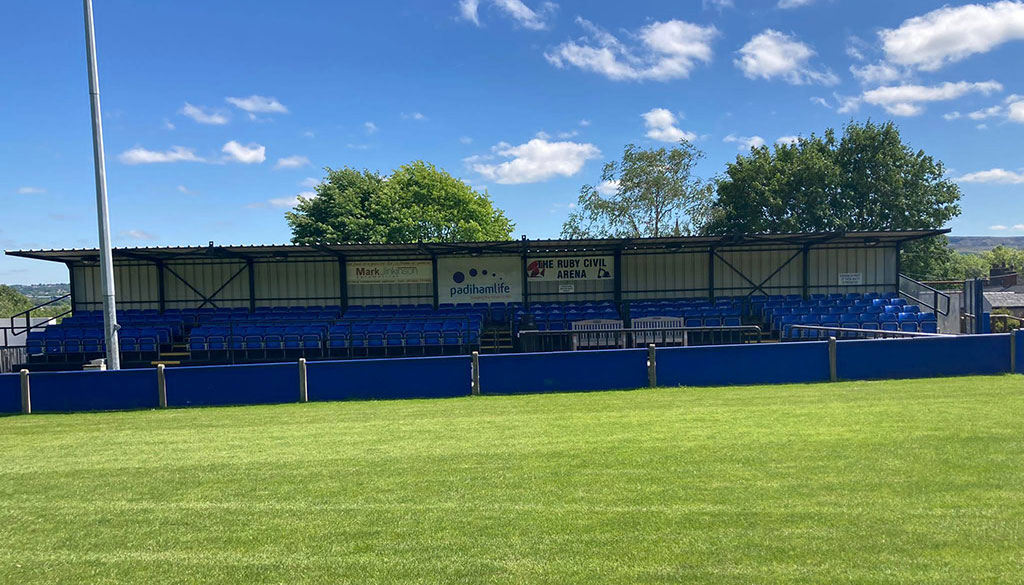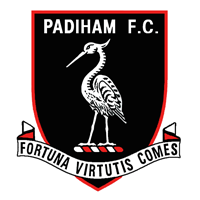
Emblematically Speaking - Padiham
Wed 27th December 2017 | Padiham | By Stewart Taylor
With apologies to Lewis Carroll, this week we go “Hunting the Stork”.
There has been a club named Padiham FC in existence, with a break between 1916 and 1949, since 1878 at which time they were known as “The Caldersiders” to reflect the position of the original ground adjacent to the River Calder.
After the end of the Second World War, a meeting was organised by Mr W.R.C. Houston in Padiham Town Hall on Wednesday 3rd September 1947 to discuss the possibility of reforming a Padiham Football and Cricket Club. It was agreed to proceed with the idea and a committee was set up to look into finances needed and the location of a sports ground.
Following a number of meetings it was agreed that a piece of land behind the Hare and Hounds Hotel in Padiham was the preferred location to site the sports ground, and that preliminary inquiries should be made with Padiham Urban District Council to see if they would be prepared to purchase the land in question, and then lease the land back to a club or clubs to be formed at a later date.
In October 1947 the Council agreed to negotiate for the purchase of the land.
The land in question was part of the Huntroyde Estate, which belonged to the Starkie Family, one of two historical family land owners in Padiham, and when asked about selling the land, liked the idea of providing Padiham with a Sports Ground and so agreed to sell it to the Council.
The Council in turn leased it to the Sports Club, which had been set up as Trustees of the land, who in turn allowed the Football Club and Cricket Club to be based at the ground.
The Starkie family were large in both numbers and influence over a long period of time in the Padiham area. The family came from Barnton in Cheshire (we know it well!).
Roger Nowell Starkie presided at the trial of the so called Lancashire Witches (a.k.a. the Pendle Witches) at Lancaster in 1612. Huge amounts have been written about the Lancashire (Pendle) Witches and quite fascinating it is to in that, unusually for the day, the trial was meticulously recorded thus leaving a rich source of information for future generations to mull over.
Those who know me well might expect a quick reference here to a well-established real ale named Pendle Witches Brew brewed by the Moorhouse Brewery in Burnley. There we are, I’ve done it now and a more than decent beer it is too.
But to continue with the Starkie family.
Edmund Starkie was one of many wealthy individuals commanded by Elizabeth I to provide money for arms to fight off the Spanish Armada in 1588.
Nicholas Le Gendre Starkie (1799 -1865) was Member of Parliament for Pontefract from 1826 -32, but was also a prominent Freemason, being Provincial Grand Master for the Western Division of Lancashire.
The East Window at St. Leonard’s Church in Padiham bears the inscription
'To the honour & Glory of God In Memory of Le Gendre N Starkie late P G M West Lancashire Freemasons who died May 15 1865. This window was erected by his widow Ann Starkie 1868'.
Close to the church is a pub called the Starkie Arms which assures the continuity of the Starkie name in the local society to this day.
In more recent times, Edmund Starkie (1871 -1958) who served as Captain in the Boer War was a prominent local promoter of the Red Cross and St John's Ambulance Brigade.
The most prominent feature of the emblem is a stork so where does that come from?
In appreciation of the Starkie family agreeing to sell the land to the council, Padiham Sports Club adopted the Stork from the Starkie family’s coat of arms as the Sports Clubs logo as in turn did the Football and Cricket Clubs when they were formed.
The emblem uses red and black as the colourways. Previously we have seen the colours used in a club emblem represent the playing colours of the team. This is not so in this case as Padiham FC play in Blue although the away kit is Red. It may well be that Red and Black feature in a previous playing kit but there is no readily accessible information to confirm that.
The final part of the emblem is the motto. ‘Virtutis Fortuna Comes’ (Latin). This translates as ‘Fortune is the Companion of Virtue’. This is the motto of the Duke of Wellington’s Regiment, sometimes known as The Duke of Boot’s although there are other nicknames for the regiment which would probably be inappropriate in a family publication.
With thanks to Alan Smith of Padiham Sports Club for his assistance in compiling this article.
 Emblematically Speaking - Padiham
Emblematically Speaking - Padiham
Wed 27th December 2017 | Padiham
By Stewart Taylor

With apologies to Lewis Carroll, this week we go “Hunting the Stork”.
There has been a club named Padiham FC in existence, with a break between 1916 and 1949, since 1878 at which time they were known as “The Caldersiders” to reflect the position of the original ground adjacent to the River Calder.
After the end of the Second World War, a meeting was organised by Mr W.R.C. Houston in Padiham Town Hall on Wednesday 3rd September 1947 to discuss the possibility of reforming a Padiham Football and Cricket Club. It was agreed to proceed with the idea and a committee was set up to look into finances needed and the location of a sports ground.
Following a number of meetings it was agreed that a piece of land behind the Hare and Hounds Hotel in Padiham was the preferred location to site the sports ground, and that preliminary inquiries should be made with Padiham Urban District Council to see if they would be prepared to purchase the land in question, and then lease the land back to a club or clubs to be formed at a later date.
In October 1947 the Council agreed to negotiate for the purchase of the land.
The land in question was part of the Huntroyde Estate, which belonged to the Starkie Family, one of two historical family land owners in Padiham, and when asked about selling the land, liked the idea of providing Padiham with a Sports Ground and so agreed to sell it to the Council.
The Council in turn leased it to the Sports Club, which had been set up as Trustees of the land, who in turn allowed the Football Club and Cricket Club to be based at the ground.
The Starkie family were large in both numbers and influence over a long period of time in the Padiham area. The family came from Barnton in Cheshire (we know it well!).
Roger Nowell Starkie presided at the trial of the so called Lancashire Witches (a.k.a. the Pendle Witches) at Lancaster in 1612. Huge amounts have been written about the Lancashire (Pendle) Witches and quite fascinating it is to in that, unusually for the day, the trial was meticulously recorded thus leaving a rich source of information for future generations to mull over.
Those who know me well might expect a quick reference here to a well-established real ale named Pendle Witches Brew brewed by the Moorhouse Brewery in Burnley. There we are, I’ve done it now and a more than decent beer it is too.
But to continue with the Starkie family.
Edmund Starkie was one of many wealthy individuals commanded by Elizabeth I to provide money for arms to fight off the Spanish Armada in 1588.
Nicholas Le Gendre Starkie (1799 -1865) was Member of Parliament for Pontefract from 1826 -32, but was also a prominent Freemason, being Provincial Grand Master for the Western Division of Lancashire.
The East Window at St. Leonard’s Church in Padiham bears the inscription
'To the honour & Glory of God In Memory of Le Gendre N Starkie late P G M West Lancashire Freemasons who died May 15 1865. This window was erected by his widow Ann Starkie 1868'.
Close to the church is a pub called the Starkie Arms which assures the continuity of the Starkie name in the local society to this day.
In more recent times, Edmund Starkie (1871 -1958) who served as Captain in the Boer War was a prominent local promoter of the Red Cross and St John's Ambulance Brigade.
The most prominent feature of the emblem is a stork so where does that come from?
In appreciation of the Starkie family agreeing to sell the land to the council, Padiham Sports Club adopted the Stork from the Starkie family’s coat of arms as the Sports Clubs logo as in turn did the Football and Cricket Clubs when they were formed.
The emblem uses red and black as the colourways. Previously we have seen the colours used in a club emblem represent the playing colours of the team. This is not so in this case as Padiham FC play in Blue although the away kit is Red. It may well be that Red and Black feature in a previous playing kit but there is no readily accessible information to confirm that.
The final part of the emblem is the motto. ‘Virtutis Fortuna Comes’ (Latin). This translates as ‘Fortune is the Companion of Virtue’. This is the motto of the Duke of Wellington’s Regiment, sometimes known as The Duke of Boot’s although there are other nicknames for the regiment which would probably be inappropriate in a family publication.
With thanks to Alan Smith of Padiham Sports Club for his assistance in compiling this article.


